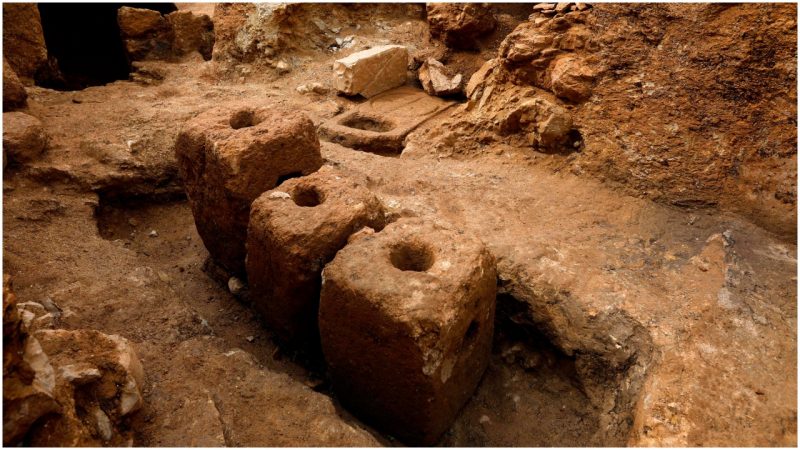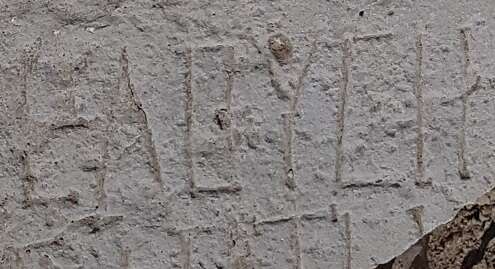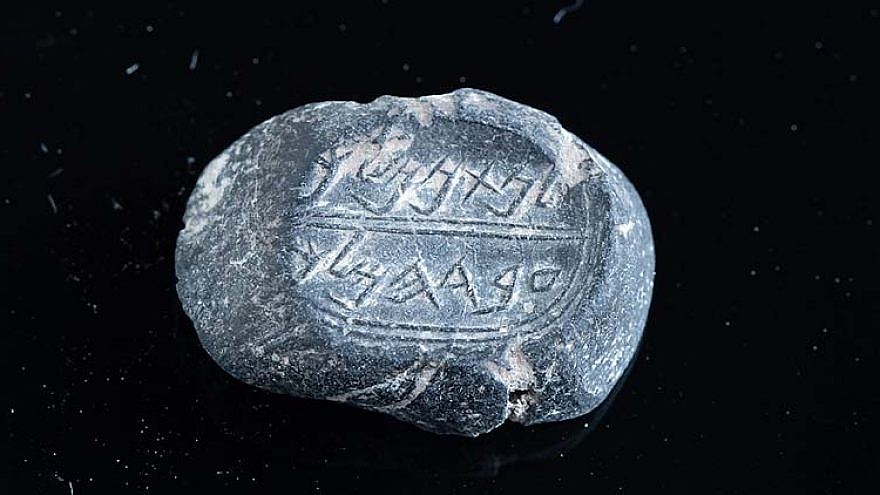Israel
2000-year-old Jewish Village Unearthed in Eastern Jerusalem
Jonathan KantrowitzatArchaeology News Report - 19 hours ago

[image: Featured image] A picture taken on March 27, 2019 shows weight stones that were part of an ancient olive press at the site of the remains of a Jewish village from the Hasmonean period (approximately 2000-years-old), which are currently being uncovered by the Israel Antiquities Authority (IAA) Photo by MENAHEM KAHANA / AFP Getty Images The remains of an ancient Jewish village from the Hasmonean period has been discovered by the Israel Antiquities Authority. The 2,000-year-old remains were discovered in the Sharafat neighborhood of Jerusalem. An elementary school was meant ... more »
Earliest reference to city of Haluza unearthed at Negev dig
Jonathan KantrowitzatArchaeology News Report - 19 hours ago

[image: Earliest written reference to city of Haluza unearthed at Negev dig] The Greek inscription reads "Elusa A stone bearing a 1,700-year-old inscription that refers to the city of Haluza (“Elusa” in Greek) has been unearthed at an excavation at the Haluza archaeological park in th Negev, some 19 miles southwest of Beersheba. The Israel Antiquities Authority explained that the inscription is the “first archaeological evidence of the name of the city of Haluza from the site itself.” Haluza was once part of the Nabataean Incense Route and has been declared a World Heritage Site... more »
City of David Excavations Reveal Jar Fragment from Period of Later Prophets
Jonathan KantrowitzatArchaeology News Report - 19 hours ago

Complete article Archaeologists working at the City of David – Givati Parking Lot excavations have uncovered a fragment of a clay jar decorated with a human face. Only two wide open eyes, a nose, one ear and a small section of the corner of the mouth survived intact. The shard is thought to date from the Persian rule of Jerusalem (fourth and fifth centuries BCE) and was found alongside other less impressive pieces from the same period. “Pottery from this period was exposed in the past in the City of David, but this is the first time that such a vessel has been found in archaeolog... more »
Ancient hidden tunnels used by rebels against the Romans are discovered in a 2,000-year-old settlement unearthed in the Israeli desert
Jonathan KantrowitzatArchaeology News Report - 19 hours ago

An ancient Jewish settlement dating back 2,000 years has been discovered in Israel. The find also exposed underground tunnels used by rebels during the Bar Kokhba revolt in 135AD. [image: An ancient settlement dating back 2,000 years has been discovered in Israel. The find also exposed underground tunnels used by rebels during the Bar Kokhba revolt in 135AD] Evidence also surfaced proving the area was being used during the First Jewish Revolt of 70AD to store goods in underground rooms and chambers. Archaeologists also unveiled parts of a watchtower, rubbish dumps, bakeries, R... more »
Found in Beer sheba - part of an oil lamp decorated with a nine-branched menorah – one of the earliest yet discovered
Jonathan KantrowitzatArchaeology News Report - 1 day ago
For the first time, the remains of a Jewish settlement of the Second Temple period have been discovered in Beer Sheva. The archaeological excavation carried out to facilitate a new neighborhood near the northern entrance to Beer Sheba has revealed evidence of Jewish day-to-day life there, including part of an oil lamp decorated with a nine-branched menorah – one of the earliest yet discovered by researchers – as well as limestone vessels used by Jews for reasons of ritual purity, a watchtower and more. [image: sherd of lamp depicting menorah] The site, dated from the 1st century C... more »
2,600-year-old seal bearing name of First Temple-era official discovered in Jeruslam
Jonathan KantrowitzatArchaeology News Report - 1 day ago

[image: A bulla inscribed with the name of Natan-Melech, official in the court of King Josiah. Source: Israel Antiquities Authority.] A bulla inscribed with the name of Natan-Melech, official in the court of King Josiah. Source: Israel Antiquities Authority. The Israel Antiquities Authority and Tel Aviv University discovered a 2,600 year old ancient bulla seal impression bearing the inscription “(belonging) to Nathan-Melech, Servant of the King” in the City of David just outside the Old City of Jerusalem, according to an announcement on Sunday. It was discovered during an arch... more »
Americas
Trees in Amazonia reveal pre-colonial human disturbance
Jonathan KantrowitzatArchaeology News Report - 2 days ago

Human history through tree rings [image: IMAGE] *IMAGE: *Brazil nut fruit and tree in the background. view more Credit: Victor L. Caetano Andrade In a new paper published in *PLOS ONE*, an international team of scientists reports the combined use of dendrochronology and historical survey to investigate the effects of societal and demographic changes on forest disturbances and growth dynamics in a neotropical tree species, the Brazil nut tree. The study, led by scientists from the National Institute for Amazonian Research, alongside colleagues from the Max Planck Institute for the Sc... more »
Rise of religion pre-dates Incas at Lake Titicaca
Jonathan KantrowitzatArchaeology News Report - 4 days ago

[image: IMAGE] *IMAGE: *The team found ritual offerings consisting of ceramic feline incense burners; sacrificed juvenile llamas; and gold, shell and stone ornaments view more Credit: Teddy Seguin An ancient group of people made ritual offerings to supernatural deities near the Island of the Sun in Lake Titicaca, Bolivia, about 500 years earlier than the Incas, according to an international team of researchers. The team's findings suggest that organized religion emerged much earlier in the region than previously thought. "People often associate the Island of the Sun with the Incas ... more »
Researchers find ancient Maya farms in Mexican wetlands
Jonathan KantrowitzatArchaeology News Report - 1 week ago

University of Cincinnati archaeologists say these farms likely produced cotton and other goods to support Yucatan trade routes University of Cincinnati [image: IMAGE] *IMAGE: *UC assistant professor Christopher Carr examines an ancient quarry in Yaxnohcah, Mexico. view more Credit: Nicholas Dunning/UC Archaeologists with the University of Cincinnati used the latest technology to find evidence suggesting ancient Maya people grew surplus crops to support an active trade with neighbors up and down the Yucatan Peninsula. They will present their findings at the annual American Association ... more »
Ancient Caribbean children helped with grocery shopping in AD 400
Jonathan KantrowitzatArchaeology News Report - 1 week ago

Florida Museum of Natural History [image: IMAGE] *IMAGE: *Archaeologists concluded that thousands of discarded shells at a site in downtown St. Thomas in the U.S. Virgin Islands are evidence of ancient Saladoid children foraging for shellfish. West Indian... view more Credit: Florida Museum of Natural History GAINESVILLE, Fla. --- Researchers have long thought that snail and clam shells found at Caribbean archaeological sites were evidence of "starvation food" eaten in times when other resources were lacking. Now, a University of Florida study suggests these shells may be evidence of... more »
Europe
A 5,000-year-old barley grain discovered in Finland changes understanding of livelihoods
Jonathan KantrowitzatArchaeology News Report - 2 days ago

[image: IMAGE] *IMAGE: *Researchers determined the age of millennia-old barley grains using radiocarbon dating. view more Credit: Santeri Vanhanen, CC-BY 4.0 licence On the basis of prior research, representatives of the Pitted Ware Culture from the Stone Age have been known as hard-core sealers, or even Inuits of the Baltic Sea. Now, researchers have discovered barley and wheat grains in areas previously inhabited by this culture, leading to the conclusion that the Pitted Ware Culture adopted agriculture on a small scale. A study carried out in cooperation with parties representing t... more »
Drinking diplomacy: Fraternal culture in early imperial Russia
Jonathan KantrowitzatArchaeology News Report - 4 days ago
Using newly discovered archival materials, Igor Fedyukin of the Higher School of Economics, in collaboration with Robert Collis (Drake University) and Ernest A. Zitser (Duke University), sheds light on the significance and context surrounding a Spanish diplomat's initiative which sought to establish an informal men's club called the 'Order of the Anti-Sober' at Peter II's court. Their study was published in *The International History Review*. In the late 17th - early 18th centuries, various fraternities, societies and associations were gaining popularity throughout Europe among the... more »
Fur discoveries in Iron Age graves testify to respect for animals
Jonathan KantrowitzatArchaeology News Report - 1 week ago

University of Helsinki [image: IMAGE] *IMAGE: *A microscopic image of deer fur found in a burial site used at the end of the Iron Age (800-1200 CE) in Vilusenharju, Tampere, central Finland. Photo: Tuija Kirkinen view more Credit: Tuija Kirkinen The doctoral dissertation of Tuija Kirkinen, MA, examines the use and significance of furs in Finland and the region of Karelia surrendered to the Soviet Union. Furs were commonly used in burials in southern Finland until the 14th and 15th century, and in northern Finland as late as the 17th century. The most prevalent group of skins are tho... more »
No comments:
Post a Comment